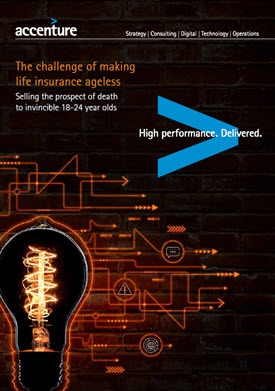
How can we build a workforce for tomorrow, today? It’s an urgent question for leaders in every industry. And Life, Pensions & Investments (LP&I) is certainly no exception. Most insurers rely on a rapidly ageing group of people that’ll be replaced (by millennials) in the next few years. The statistics put this into perspective. Right now, 60-65 percent of the workforce in this industry is aged 40 and upwards. The majority of the remainder are millennials. In just three to five years, that will flip. How successful companies are in attracting, retaining and rewarding the new talent that’ll staff and run their businesses will, literally, determine their future.
Like every organisation, it’s an issue we’re confronting at Accenture. And we believe the results of a recent initiative in our LP&I practice have something valid (and timely) to tell us all. We invited the most junior members of our LP&I team to deliver a presentation back to us. The brief? Identify an issue facing the insurance industry that you’re passionate about. Discuss it, research it and tell us why it’s significant, why the industry should take notice. Surprise us, in other words.
The five-strong team took the idea and ran with it. Using workshops, roundtables and on-the-ground research, they developed a unique point of view on a familiar issue: where next for the life insurance industry? It’s no secret that the industry faces some serious challenges. But it took a group of millennials, our own ‘leaders of the future’, to bring these challenges to life.
What we heard from them fascinated us. By switching the hierarchy and democratising thought leadership (instead of the old top-down process), we’d accessed a completely new perspective. So what did they have to say? You can read their point of view here. But summing up, they had some timely messages on how and why life insurers must act now to start future-proofing their business models
As young consumers of financial products and services themselves, they understand first-hand what it’s like to deal with companies in this industry. And they’re unimpressed with what’s on offer. Life insurers are lagging their non-life counterparts in some key areas when it comes to understanding and engaging with millennials. And that’s doubly dangerous. After all, millennials aren’t just their next generation of customers. They’re also their next generation of employees.
Top-line message, millennials expect to interact digitally. Fifteen percent of them shop online (versus just six percent across all age groups). They’re twice as likely to go online to manage their finances, and they’re more likely than anyone else to be willing to share their personal data with companies: 23 percent of them would do so in exchange for more personalised, relevant products. They also feel frustrated. Eighty percent of them feel they’d benefit from more (and better) financial information – but they don’t know where to go to find it. And, even if they did, at their stage in life they feel invincible, which makes life insurance a very tough sell.
 All this probably makes painful reading for life insurers. But they can’t afford to ignore this feedback. It points to a need to become more customer-centric rather than pushing product: turning life insurance from a tough sell into an easier one means using digital to engage with the customer more closely and show the product’s real value. And the providers that achieve this stand to benefit enormously. After all, as a demographic, 18-24 year-olds are low risk with high lifetime value. Crucially too, they’re more open to digital interactions than anyone else. Provided insurers can make themselves relevant to this group, they’ll differentiate themselves from the competition and, at the same time, make themselves attractive employers for the next generation of talent. That’s never been more important than it is now, with the tech industry competing hard for the brightest and best new graduates.
All this probably makes painful reading for life insurers. But they can’t afford to ignore this feedback. It points to a need to become more customer-centric rather than pushing product: turning life insurance from a tough sell into an easier one means using digital to engage with the customer more closely and show the product’s real value. And the providers that achieve this stand to benefit enormously. After all, as a demographic, 18-24 year-olds are low risk with high lifetime value. Crucially too, they’re more open to digital interactions than anyone else. Provided insurers can make themselves relevant to this group, they’ll differentiate themselves from the competition and, at the same time, make themselves attractive employers for the next generation of talent. That’s never been more important than it is now, with the tech industry competing hard for the brightest and best new graduates.
As I said, you can click through to read the full report. I’ve written this blog to showcase how a new approach to millennial talent at Accenture has delivered some unprecedented insights. By plugging the ‘new’ into your organisation’s central nervous system isn’t just an interesting exercise. We’d argue it’s essential for survival. And now’s a good time to start. Thanks for reading.